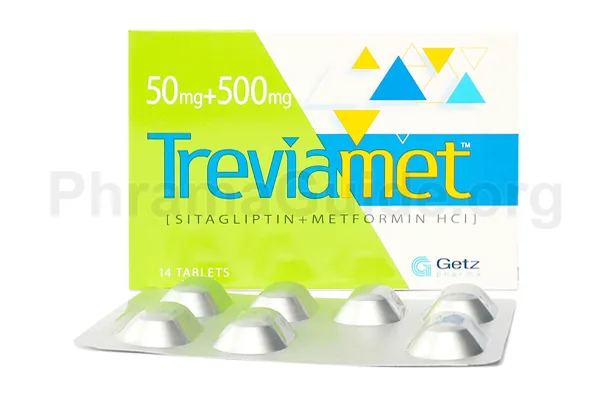Treviamet tablet is a combination of dipeptidyl peptidase-4 and biguanide (two anti-diabetic drugs). It is primarily used for the treatment of type 2 diabetes. Following are some common uses of Treviamet Tablet:
- Type 2 Diabetes Management: Treviamet tablet is used to control blood sugar levels in individuals with type 2 diabetes. Using Treviamet helps to increase levels of incretin hormones, such as glucagon-like peptide-1 (GLP-1), which stimulates insulin release reduces glucagon secretion, and also reduces hepatic glucose production, and improves insulin sensitivity.
- Lowering Blood Glucose Levels: Treviamet tablet is effective in reducing elevated blood glucose levels in individuals with type 2 diabetes. By targeting different aspects of glucose regulation, these medications work synergistically to improve glycemic control.
- Improving Insulin Sensitivity: The use of Treviamet helps improve the body’s response to insulin, making the cells more receptive to its effects. This can result in better glucose uptake and utilization by the cells, thereby reducing insulin resistance.
Off-label Uses of Treviamet Tablet
- Prediabetes: Treviamet may be used off-label in individuals with prediabetes, a condition characterized by higher-than-normal blood sugar levels but not yet meeting the criteria for a diabetes diagnosis. It may help improve glycemic control and potentially delay or prevent the progression of type 2 diabetes.
- Gestational Diabetes: Gestational diabetes is a form of diabetes that occurs during pregnancy. While the primary treatment is lifestyle modifications and insulin, in some cases, Treviamet may be used off-label as an adjunct therapy to help control blood sugar levels.
- Weight Management: While not the primary indication, Treviamet is sometimes used off-label for weight management in individuals without diabetes. It may be prescribed in cases where weight loss is desired, especially in those with insulin resistance or metabolic syndrome.

What is Treviamet?
Treviamet is one of the leading brands with a combination of Sitagliptin and Metformin, manufactured and marketed by Getz Pharmaceuticals (Pvt) Ltd, Pakistan.
Treviamet Alternatives : Other Similar Brands
The following are some alternative brands of Treviamet and their manufacturers.
- Sitaglu Met : Hilton Pharmaceuticals (Pvt) Ltd, Pakistan.
- Sita-Met : (CCL) Consolidated Chemical Laboratories (Pvt) Ltd, Pakistan.
- Inosita-Plus : Pharmevo Pakistan (Pvt) Ltd.
- Gliptin Plus : Himont Pharmaceuticals (Pvt) Ltd, Pakistan.
- Duvel Plus : Martin Dow Pharma, Pakistan.
- Alosita-Met : Saffron Pharmaceuticals (Pvt) Ltd, Pakistan.
- Tagipmet : Highnoon Laboratories Ltd, Pakistan.
- Neoglip : Atco Laboratories (Pvt) Ltd, Pakistan.
- Sitagen-M : Ferozsons Laboratories Ltd, Pakistan.
- Gvia M : Genix Pharmaceuticals (Pvt) Ltd, Pakistan.
Treviamet : Available Formulations and Strengths
Presently, Treviamet is available in Tablet Form with the following strengths.
Treviamet 50/500 : Sitagliptin 50mg + Metformin 500mg strengths
Treviamet 50/1000 : Sitagliptin 50mg + Metformin 1000mg (1g) strengths
Who Should Not Use Treviamet?
While Treviamet is generally safe and effective for many individuals with type 2 diabetes, there are some contraindications and precautions to be aware of.
- Hypersensitivity: If an individual has a known hypersensitivity or allergy to sitagliptin, metformin, or any other components of Treviamet, should avoid its use.
- Severe kidney impairment: Av active ingredient of Treviamet is primarily eliminated from the body through the kidneys. Therefore, individuals with severe kidney impairment or end-stage renal disease (ESRD) are typically advised against using metformin.
- Acute or chronic metabolic acidosis: Treviamet use should be avoided in individuals with a history of metabolic acidosis or conditions that can predispose them to metabolic acidosis, such as diabetic ketoacidosis. Metabolic acidosis is a serious condition that can occur when there is an excessive buildup of acids in the body.
- Heart failure: Treviamet contains Sitagliptin, which should be used with caution in individuals with a history of heart failure. Close monitoring of heart function is recommended during treatment.
- Severe liver impairment: Severe liver impairment can affect the metabolism and elimination of Treviamet. Therefore, its use should be avoided or closely monitored in individuals with severe liver dysfunction.
- Pregnancy and breast-feeding: The safety of Treviamet or its ingredients, use during pregnancy and breastfeeding has not been well-established. If you are pregnant or breastfeeding, it is important to discuss the risks and benefits with your healthcare provider.
What is the Recommended Daily Dosage of Treviamet?
Treviamet Dose for Type 2 Diabetes:
- For Treatment: One Tablet of 50/1000mg, once daily. This can be taken with or without food.
- For Maintenance: One Tablet of 50/500mg,
- The maximum recommended daily dose is typically around 4 tablets of Treviamet 50/500mg per day.
How Treviamet Works?
Treviamet contains two active ingredients and they both work to help control blood sugar levels.
Sitagliptin: It belongs to a class of medications known as dipeptidyl peptidase-4 (DPP-4) inhibitors. The primary mode of action of sitagliptin is through the inhibition of the enzyme DPP-4, which is responsible for the breakdown of incretin hormones, particularly glucagon-like peptide-1 (GLP-1) and glucose-dependent insulinotropic polypeptide (GIP). By inhibiting DPP-4, sitagliptin prolongs the activity of GLP-1 and GIP, leading to increased insulin secretion from the pancreas and decreased glucagon release. This helps to reduce blood glucose levels, particularly after meals. Sitagliptin’s action is glucose-dependent, meaning it enhances insulin secretion when blood glucose levels are elevated but has minimal effect when glucose levels are within the normal range.
Metformin: It is a biguanide medication that primarily works by reducing hepatic glucose production and improving insulin sensitivity in peripheral tissues such as muscles and fat cells. The exact mechanism of action of metformin is not completely understood, but it is believed to involve multiple pathways. Metformin activates an enzyme called AMP-activated protein kinase (AMPK), which regulates various metabolic processes. Activation of AMPK by metformin leads to the inhibition of hepatic gluconeogenesis, reducing the amount of glucose produced by the liver. Metformin also enhances peripheral glucose uptake by increasing insulin sensitivity in target tissues. Additionally, metformin may have effects on intestinal glucose absorption and utilization of glucose by cells.

Leave A Comment